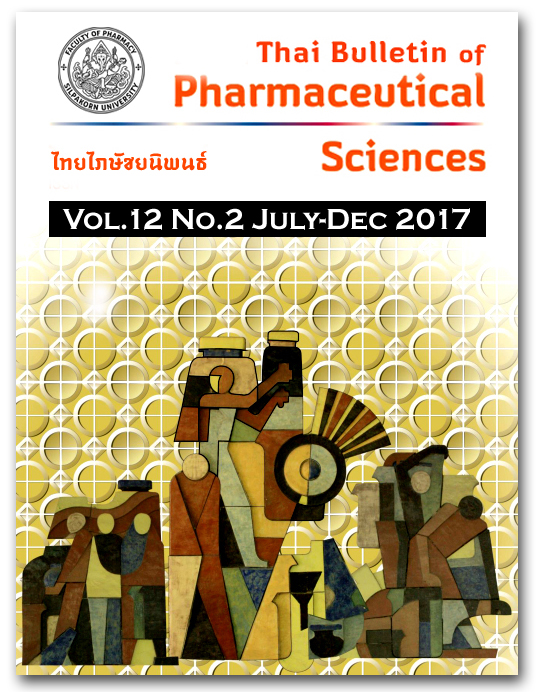DRUG-INDUCED LIVER INJURY
DOI:
https://doi.org/10.69598/tbps.12.2.69-83Keywords:
การบาดเจ็บที่ตับเนื่องจากยา, RUCAM, ปัจจัยเสี่ยง, drug-induced liver injury, risk factorsAbstract
การบาดเจ็บที่ตับเนื่องจากยา (Drug-Induced Liver Injury, DILI) โดยทั่วไปพบอุบัติการณ์ได้น้อยแต่ผลที่เกิดขึ้นมีความรุนแรง อาการแสดงทางคลินิกมีความผันแปรตั้งแต่ไม่มีอาการแสดงแต่มีระดับเอนไซม์ตับเพิ่มขึ้นจนถึงตับวายจนเสียชีวิต สำหรับกลไกการเกิดการบาดเจ็บที่ตับจากยาอาจเกิดแบบชนิดที่สามารถทำนายได้หรือทำนายไม่ได้ สิ่งที่ช่วยในการวินิจฉัยได้แก่ การตัดสาเหตุอื่น ๆ ที่สอดคล้องตามรูปแบบการเกิด DILI ที่เป็นไปได้ออก นอกจากนี้ในผู้ป่วยที่สงสัยว่าเกิดการบาดเจ็บที่ตับจากยา การใช้อัลกอริทึ่ม เช่น Roussel Uclaf Causality Assessment Method (RUCAM) อาจมีประโยชน์ช่วยในการวินิจฉัยการบาดเจ็บที่ตับว่าเกิดจากยาหรือไม่ สิ่งแรกที่ควรปฏิบัติในการรักษา DILI คือการหยุดใช้ยาที่สงสัย การรักษาส่วนใหญ่เป็นตามอาการและค้นหาปัจจัยเสี่ยงเพื่อไม่ให้อาการแย่ลง สำหรับการใช้ยาบางตัวการตรวจติดตามค่าเอนไซม์อะลานีนอะมิโนทรานส์เฟอเรสอาจมีความจำเป็นแต่วิธีป้องกันที่ดีที่สุดคือ การให้ความรู้แก่ผู้ป่วยเกี่ยวกับอาการแสดงว่าเกิดการบาดเจ็บที่ตับรุนแรง ได้แก่ ปวดท้องด้านบนขวา คลื่นไส้ อาเจียนและดีซ่านเมื่อใช้ยานั้น ในบทความนี้บรรยายถึงข้อมูลระบาดวิทยา ปัจจัยเสี่ยง อาการแสดงทางคลินิก ตัวอย่างยาที่มีรายงาน DILI และวิธีการประเมิน DILI โดยมีวัตถุประสงค์เพื่อช่วยเภสัชกรในการจัดการเกี่ยวกับ DILI
Drug-induced liver injury (DILI) has a low incidence of occurrence but it can cause serious outcomes. The clinical presentations of DILI are variables ranging from asymptomatic individuals with mildly elevated liver enzymes to fulminant liver failure leading to death. DILI can result from either intrinsic or idiosyncratic mechanism. Exclusion of other possible etiologies according to the pattern of liver injury is necessary for the diagnosis. Moreover, diagnostic algorithm namely the Rousel Uclaf Causality Assessment Method (RUCAM) may be used as a tool to identify DILI in the suspected case. Discontinuation of the suspected agent should be done as soon as DILI is detected. Management of DILI is usually symptomatic treatment and identification of risk factors to prevent progression. Careful monitoring of alanine aminotransferase serum level might be needed in some cases. The best way to prevent DILI is to educate patients of the signs and symptoms of severe liver injury such as right upper quadrant abdominal pain, nausea, vomiting and jaundice. This article describes the epidemiology, risk factors, clinical signs & symptoms, causative drugs and assessment of DILI in order to assist the pharmacists in managing DILI.
Downloads
Published
How to Cite
Issue
Section
License
All articles published and information contained in this journal such as text, graphics, logos and images is copyrighted by and proprietary to the Thai Bulletin of Pharmaceutical Sciences, and may not be reproduced in whole or in part by persons, organizations, or corporations other than the Thai Bulletin of Pharmaceutical Sciences and the authors without prior written permission.



